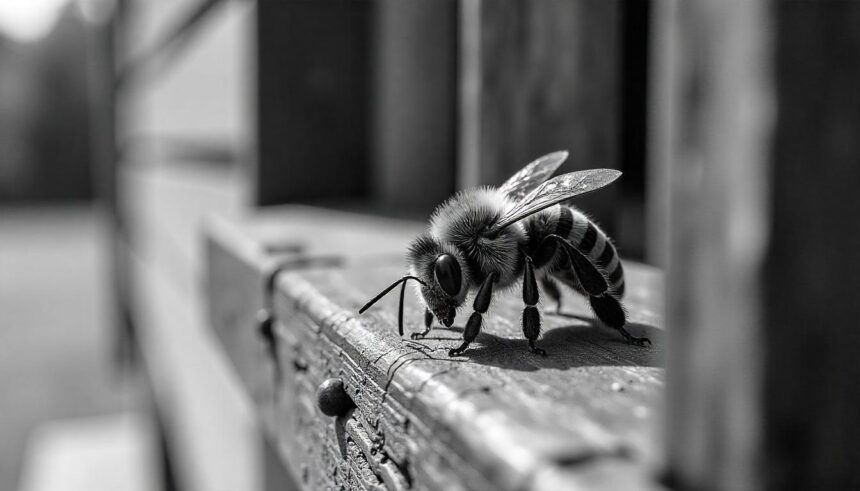Introduction
Carpenter bees may seem harmless at first, but they can cause significant damage to wooden structures over time. Unlike termites, they do not consume wood, but their tunneling activities weaken wooden surfaces and can lead to costly repairs. If you’ve noticed carpenter bees buzzing around your home or drilling holes in wooden structures, it’s time to take action. This guide will provide you with effective ways to identify, eliminate, and prevent carpenter bee infestations using both natural and chemical methods.
What Are Carpenter Bees?
Carpenter bees (genus Xylocopa) are large, solitary bees that resemble bumblebees but have a shiny, hairless abdomen. They are often mistaken for bumblebees due to their similar size and buzzing sound. Unlike social bees that live in colonies, carpenter bees prefer to nest alone, creating tunnels in untreated or weathered wood.
Why Are Carpenter Bees a Problem?
- Structural Damage – Carpenter bees drill holes into wooden surfaces, weakening structures over time.
- Repetitive Nesting – They return to the same nesting sites year after year, increasing damage.
- Woodpecker Attraction – Woodpeckers feed on carpenter bee larvae, causing additional damage by pecking at the wood.
- Aesthetic Issues – Their tunnels and sawdust can make wooden structures look unsightly.
- Potential Stinging Threat – While male carpenter bees are harmless, female bees can sting if provoked.
How to Identify Carpenter Bee Nests
Before taking action, it’s crucial to confirm that you have a carpenter bee problem. Here are the signs to look for:
- Round Entry Holes: Carpenter bees create nearly perfect round holes (about ½ inch in diameter) in wooden surfaces.
- Sawdust Piles: You may find small piles of sawdust beneath the holes.
- Bee Activity: Large bees hovering around wooden structures, particularly in spring and summer.
- Tunneling Sounds: A faint scratching noise from inside wooden beams or eaves.
Methods to Get Rid of Carpenter Bees
There are several ways to eliminate carpenter bees, ranging from natural deterrents to chemical treatments. Below are the most effective methods:
Natural Remedies
If you prefer eco-friendly solutions, try these natural remedies to repel and remove carpenter bees:
- Citrus Spray
- Carpenter bees dislike citrus scents.
- Boil water with citrus peels (lemon, orange, or lime) and let it steep.
- Once cool, pour the mixture into a spray bottle and spray the bee holes and surrounding wood.
- Essential Oils
- Mix a solution of water and essential oils like tea tree, peppermint, or lavender.
- Spray directly into their holes and around wooden areas.
- Repeat every few days until the bees are gone.
- Almond Oil or Vinegar
- Apply almond oil or white vinegar inside the tunnels.
- The strong smell repels bees and discourages them from returning.
- Bee Traps
- Install store-bought or homemade bee traps near the nesting sites.
- These traps lure bees inside, preventing them from escaping.
- Loud Noises and Vibrations
- Vibrations disturb carpenter bees and may drive them away.
- Place a loud radio near their nest or use vibrating tools on the wood.
Chemical Solutions
For severe infestations, chemical treatments may be necessary:
- Insecticidal Dust
- Use an insecticidal dust labeled for carpenter bees (such as boric acid or carbaryl).
- Apply the dust directly into the tunnels.
- Wait 24-48 hours before sealing the holes.
- Bee Sprays and Aerosols
- Use residual sprays that specifically target carpenter bees.
- Spray into the tunnels and around wooden areas where bees are active.
- Foam Sealants
- Some pesticide foams expand inside the tunnels, eliminating bees effectively.
- Always follow the manufacturer’s instructions for safe use.
Preventing Future Infestations
Once you’ve removed the carpenter bees, take these preventive steps to ensure they don’t return:
- Seal Existing Holes
- Fill tunnels with wood putty or caulk.
- Paint or varnish over the patched area to prevent re-entry.
- Paint or Stain Wood
- Carpenter bees prefer untreated wood.
- Use exterior paint, varnish, or polyurethane coatings to make wood less appealing.
- Install Bee-Resistant Materials
- Replace wooden surfaces with composite materials or pressure-treated wood.
- Consider covering wooden beams with metal flashing or vinyl siding.
- Use Bee Repellents
- Hang decoy wasp nests (carpenter bees avoid areas with wasps).
- Regularly apply citrus or essential oil sprays.
- Install Physical Barriers
- Use mesh screens or netting over vulnerable areas like eaves and beams.
- Install metal brackets on wooden railings to discourage nesting.
When to Call a Professional
If your carpenter bee infestation is severe or persistent despite your efforts, it may be best to call a professional pest control service. Experts can safely remove the bees and provide long-term solutions to prevent reinfestation.
Conclusion
Carpenter bees may seem like a minor nuisance, but their tunneling activities can lead to significant damage over time. By identifying their nests early and using effective natural or chemical treatments, you can eliminate them before they cause serious harm. Taking preventive measures, such as sealing holes and treating wood, will help ensure that they don’t return in the future. With the right approach, you can protect your home from these wood-boring pests while maintaining a bee-friendly environment elsewhere in your garden.







